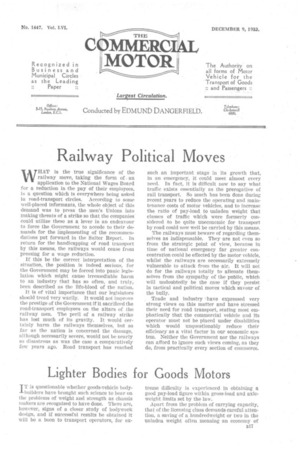Lighter Bodies for Goods Motors
Page 31

Page 32

If you've noticed an error in this article please click here to report it so we can fix it.
TT is questionable whether goods-vehicle body builders have brought such science to bear on the problems of weight and strength as chassis makers are recognized to have done. There are, however, signs of a closer study of bodywork design, and if successful results be obtained it will be a boon to transport operators, for ex treme difficulty is experienced in obtaining a good pay-load figure within gross-load and axleweight limits set by the law.
Apart from the problem of carrying capacity, that of the licensing class demands careful attention, a saving of a hundredweight or two in the unladen weight often meaning an economy of several pounds in the annual tax, or a considerable difference in the speed at which a vehicle may legally run.
The lightening of cabs has been successfully effected by several bodybuilders without impairing the strength, and now some of the more enterprising concerns are turning to the matter of longitudinal body runners and transverse bearers. The latter often must be deep, and demands of strength necessitate the use of oak, so that the weight becomes a really big item. Metal cross-bearers of different types are now being considered, which will afford a welcome weight reduction and may yield improved rigidity. Lighter armoured panelling is another promising possibility.
If difficulties be met at first, means should be sought to overcome them instead of reverting to the familiar constructional methods, for undoubtedly there is considerable scope for a reduction in goods-vehicle body weights, and steel pressings, tubes, light-alloy castings and extruded sections offer many possible opportunities. Some bus bodies are trussed, and this method might well be applied to large vans.
A Scheme to Curtail Unnecessary Licensing Opposition.
ON previous occasions we have referred to the lengthy procedure involved in licensing public-service vehicles and to the steps that are being taken to speed up matters. In the latter connection we make a suggestion which will, we think, have a useful effect in reducing the amount of unnecessary opposition to the granting of licences at the sittings of Traffic Commissioners and will thus accelerate the issue of the licences, as well as saving the time of all concerned.
Every objector to the granting or renewal of a licence should be required to deposit a certain sum, say £2 2s., to be forfeited if, in the opinion of the Commissioners who hear the case, the opposition be frivolous ; power should also be given to the Commissioners to call for the payment of costs, on a definite scale, by the objector.
Such a scheme should deter operators and others from making unnecessary objections, which are becoming a great nuisance to the Commissioners and applicants alike.




























































































